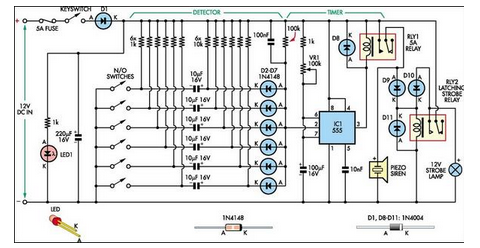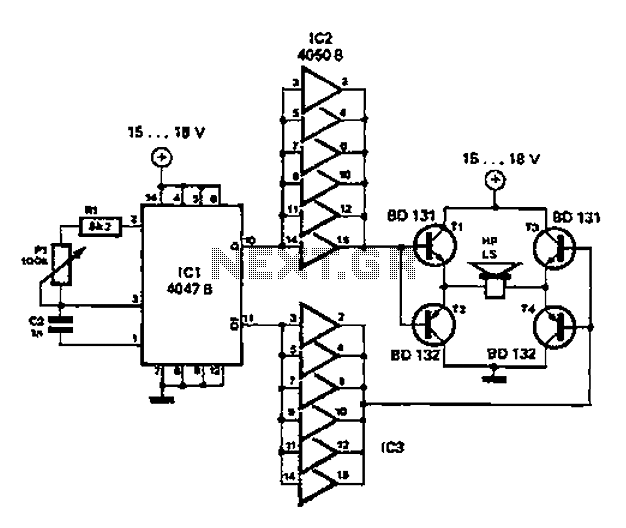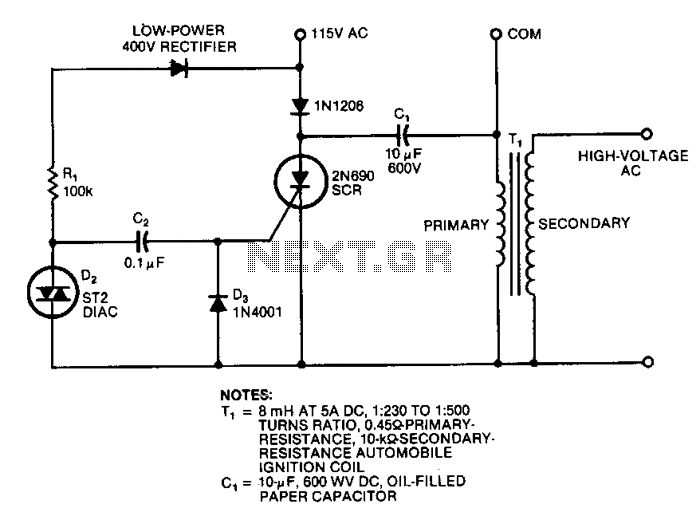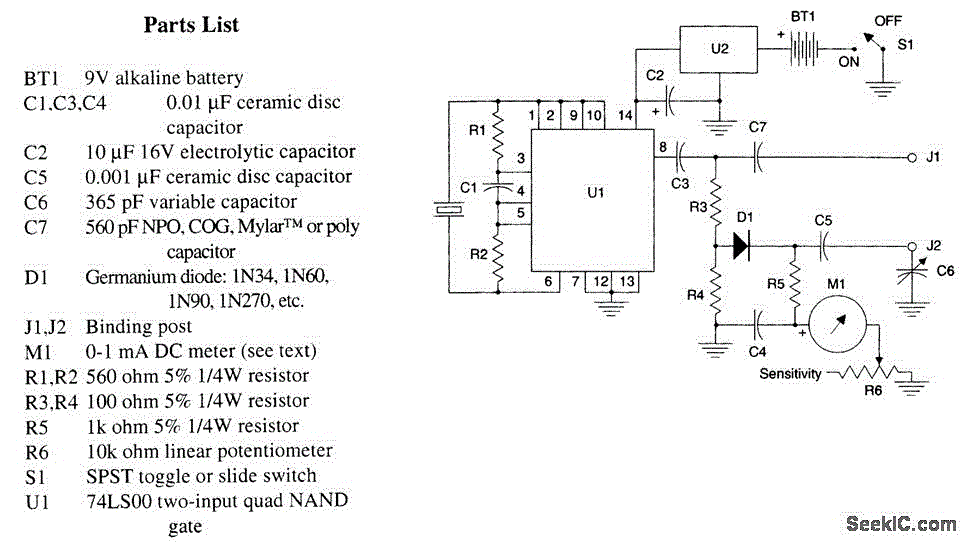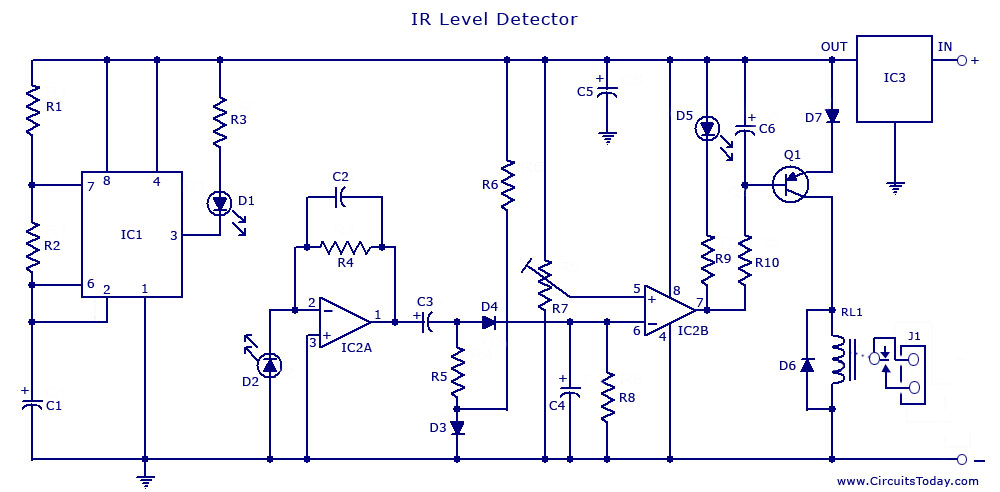
Simple Electromagnetic Field Detector Schematic

This circuit is sensitive to low-frequency electromagnetic radiation and can detect hidden wiring or the field surrounding a transformer. A radial type inductor is used as a probe, which effectively responds to low-frequency changing magnetic and electric fields. Ordinary headphones are utilized for detection, and the field surrounding a transformer is perceived as a 50 or 60Hz buzz. The circuit consists of a length of screened cable threaded through an old pen tube, with the ends soldered to a radial type can inductor, specifically a 1mH inductor that fits snugly into the pen tube. The opposite end of the cable connects to the input of an operational amplifier (op-amp). Any op-amp can be used, but better results may be achieved with a low-noise FET type, such as the LF351. A 2.2M potentiometer serves as a gain control, and the output is connected to a pair of headphones, which can be stereo types wired as mono. An 8-ohm headphone type was used, but the circuit should function well with higher impedance types as well. The probe can be connected via screened cable and a 3.5mm stereo plug and socket. This circuit demonstrates good sensitivity, capable of detecting mains wiring buried an inch in plaster with precision. A small load on the electric supply, such as a 20-watt desk lamp, is sufficient. The hum field around a transformer can be detected from over 7 inches away. Domestic appliances, including video players and alarm clocks, produce interference that can be detected with the probe. Additionally, the electric field surrounding a loudspeaker or earpiece is also audible. For example, placing the probe near a telephone earpiece allows for detection of signals. A telephone pickup coil can be substituted for the inductor if desired. An improved version of this circuit with a meter output is planned for future development.
This circuit operates as an electromagnetic field detector, leveraging a radial inductor as a sensitive probe to capture low-frequency electromagnetic radiation. The design is straightforward, with a focus on utilizing readily available components. The inductor, with a value of 1mH, serves as the main sensing element, converting changes in magnetic fields into electrical signals. The choice of op-amp, particularly the LF351, enhances the circuit's performance by minimizing noise, which is crucial when detecting low-level signals.
The gain control provided by the 2.2M potentiometer allows for fine-tuning of the output signal, enabling the user to adjust the sensitivity based on the environmental conditions or the specific application. The output is designed to interface with headphones, making the circuit user-friendly for real-time audio feedback. The inclusion of a 3.5mm stereo plug facilitates easy connection and disconnection of the probe, enhancing the circuit's versatility.
The circuit's ability to detect hidden wiring, even when buried under plaster, showcases its practical applications in various fields, including electrical maintenance, safety inspections, and even hobbyist electronics projects. The effective range of detection for transformer hum and the interference from domestic appliances demonstrates its utility in identifying electromagnetic fields in everyday environments.
Future enhancements, such as the implementation of a meter output, would provide a visual representation of the detected fields, further increasing the circuit's functionality and ease of use. Overall, this circuit serves as a valuable tool for those interested in exploring the electromagnetic fields present in their surroundings.This circuit is sensitive to low frequency electromagnetic radiation and will detect for example hidden wiring or the field that encompasses a transformer. Pickup is by a radial type inductor, used as a probe which responds well to low frequency changing magnetic and electric fields.
Ordinary headphones are used to for detection. The field that su rrounds a transformer is heard as a 50 or 60Hz buzz. The circuit is below:- I threaded a length of screened cable through an old pen tube and soldered the ends to a radial type can inductor. I used 1mH. The inductor fitted snugly into the pen tube. The opposite end of the cable connects to the input of the op-amp. Any op-amp should work here, possibly better results may be achieved with a low noise FET type such as the LF351.
The 2M2 potentiometer acts as a gain control and the output is a pair of headphones. Stereo types can be used if they are wired as mono. I used an 8 ohm type, but the circuit should work equally well with higher impedance types. The probe (shown below) may be connected via screened cable and a 3. 5mm stereo plug and socket. The sensitivity of this circuit is good. Mains wiring buried an inch in plaster can be detected with precision. A small load on the electric supply is all that is needed; a 20 watt desk lamp or similar will suffice. The hum field surrounding a transformer can be detected oat over 7 inches. Domestic appliances such as videos and alarm clocks all produce interference which can be heard with the probe.
The electric field surrounding a loudspeaker or earpiece can also be heard. Try lifting a telephone and place the probe near the earpiece. A telephone pickup coil can be used in place of the inductor if desired. I will make an improved version of this circuit with a meter output later. link 🔗 External reference
This circuit operates as an electromagnetic field detector, leveraging a radial inductor as a sensitive probe to capture low-frequency electromagnetic radiation. The design is straightforward, with a focus on utilizing readily available components. The inductor, with a value of 1mH, serves as the main sensing element, converting changes in magnetic fields into electrical signals. The choice of op-amp, particularly the LF351, enhances the circuit's performance by minimizing noise, which is crucial when detecting low-level signals.
The gain control provided by the 2.2M potentiometer allows for fine-tuning of the output signal, enabling the user to adjust the sensitivity based on the environmental conditions or the specific application. The output is designed to interface with headphones, making the circuit user-friendly for real-time audio feedback. The inclusion of a 3.5mm stereo plug facilitates easy connection and disconnection of the probe, enhancing the circuit's versatility.
The circuit's ability to detect hidden wiring, even when buried under plaster, showcases its practical applications in various fields, including electrical maintenance, safety inspections, and even hobbyist electronics projects. The effective range of detection for transformer hum and the interference from domestic appliances demonstrates its utility in identifying electromagnetic fields in everyday environments.
Future enhancements, such as the implementation of a meter output, would provide a visual representation of the detected fields, further increasing the circuit's functionality and ease of use. Overall, this circuit serves as a valuable tool for those interested in exploring the electromagnetic fields present in their surroundings.This circuit is sensitive to low frequency electromagnetic radiation and will detect for example hidden wiring or the field that encompasses a transformer. Pickup is by a radial type inductor, used as a probe which responds well to low frequency changing magnetic and electric fields.
Ordinary headphones are used to for detection. The field that su rrounds a transformer is heard as a 50 or 60Hz buzz. The circuit is below:- I threaded a length of screened cable through an old pen tube and soldered the ends to a radial type can inductor. I used 1mH. The inductor fitted snugly into the pen tube. The opposite end of the cable connects to the input of the op-amp. Any op-amp should work here, possibly better results may be achieved with a low noise FET type such as the LF351.
The 2M2 potentiometer acts as a gain control and the output is a pair of headphones. Stereo types can be used if they are wired as mono. I used an 8 ohm type, but the circuit should work equally well with higher impedance types. The probe (shown below) may be connected via screened cable and a 3. 5mm stereo plug and socket. The sensitivity of this circuit is good. Mains wiring buried an inch in plaster can be detected with precision. A small load on the electric supply is all that is needed; a 20 watt desk lamp or similar will suffice. The hum field surrounding a transformer can be detected oat over 7 inches. Domestic appliances such as videos and alarm clocks all produce interference which can be heard with the probe.
The electric field surrounding a loudspeaker or earpiece can also be heard. Try lifting a telephone and place the probe near the earpiece. A telephone pickup coil can be used in place of the inductor if desired. I will make an improved version of this circuit with a meter output later. link 🔗 External reference

